Boost Speed with Resistance Training Techniques
How to Use Resistance Training to Build Speed in Karate Techniques
Karate requires agility, precision, speed, and power. Speed often determines the success of a technique or strike. The faster you deliver a technique, the more effective it becomes. Achieving that speed requires dedicated training, including resistance training. This blog explores how resistance training enhances speed in karate.
Understanding Resistance Training
Resistance training involves exercises that force your muscles to work against an external force. You can use weights, resistance bands, or your own body weight. Strengthening your muscles improves your karate performance.
Types of Resistance Training
Several resistance training types benefit karate practitioners. Here are effective options:
1. **Weight Training**: Use free weights, machines, or kettlebells. Focus on compound movements like squats, deadlifts, and bench presses. These exercises engage multiple muscle groups, enhancing overall power for quicker, more forceful strikes.
2. **Resistance Bands**: Resistance bands are versatile and easy to integrate into your karate routine. Use them for shadow boxing, practicing techniques, or warming up. Bands provide constant tension, improving muscle engagement and developing strength for explosive movements.
3. **Bodyweight Exercises**: Perform push-ups, pull-ups, lunges, and dips to build strength without equipment. You can do these exercises anywhere, developing functional strength for martial arts performance.
4. **Plyometric Exercises**: Plyometrics involve explosive movements that enhance speed and power. Use jump squats, box jumps, and clap push-ups to build fast-twitch muscle fibers essential for quick, powerful karate movements.
Incorporating Resistance Training into Your Routine
To build speed through resistance training, follow these steps:
1. **Choose the Right Exercises**: Select exercises that target muscles used in karate techniques. Focus on legs for kicking power, core for stability, and upper body for striking and blocking.
2. **Use Progressive Overload**: Gradually increase resistance, intensity, or volume in your workouts. This principle ensures continuous improvement, helping your muscles adapt and increasing strength and speed.
3. **Combine Techniques**: Integrate resistance training with karate practice. For instance, perform a roundhouse kick with ankle weights or use resistance bands during punches. This builds strength while maintaining proper technique under resistance.
4. **Include Recovery**: Allow adequate recovery time between workouts. Recovery helps prevent injury and ensures your muscles rebuild stronger.
Conclusion
Resistance training effectively builds speed in karate. Implement these strategies to enhance your performance and achieve your martial arts goals.
Below are related products based on this post:
FAQ
What is resistance training and how does it benefit karate practitioners?
Resistance training involves exercises that make your muscles work against an external force, using weights, bands, or body weight. It benefits karate practitioners by strengthening muscles, which enhances overall performance and aids in delivering quicker, more effective techniques.
What types of resistance training should I incorporate into my karate routine?
Effective types of resistance training for karate include weight training (using free weights and machines), resistance bands (for shadow boxing and technique practice), bodyweight exercises (like push-ups and lunges), and plyometric exercises (such as jump squats). Each type targets different muscle groups and improves strength and speed.
How can I effectively integrate resistance training into my karate practice?
To integrate resistance training into your karate practice, choose exercises that target relevant muscle groups, use progressive overload to continuously challenge your muscles, combine resistance training with actual karate techniques, and ensure adequate recovery time to prevent injuries and promote muscle rebuilding.















Post Comment